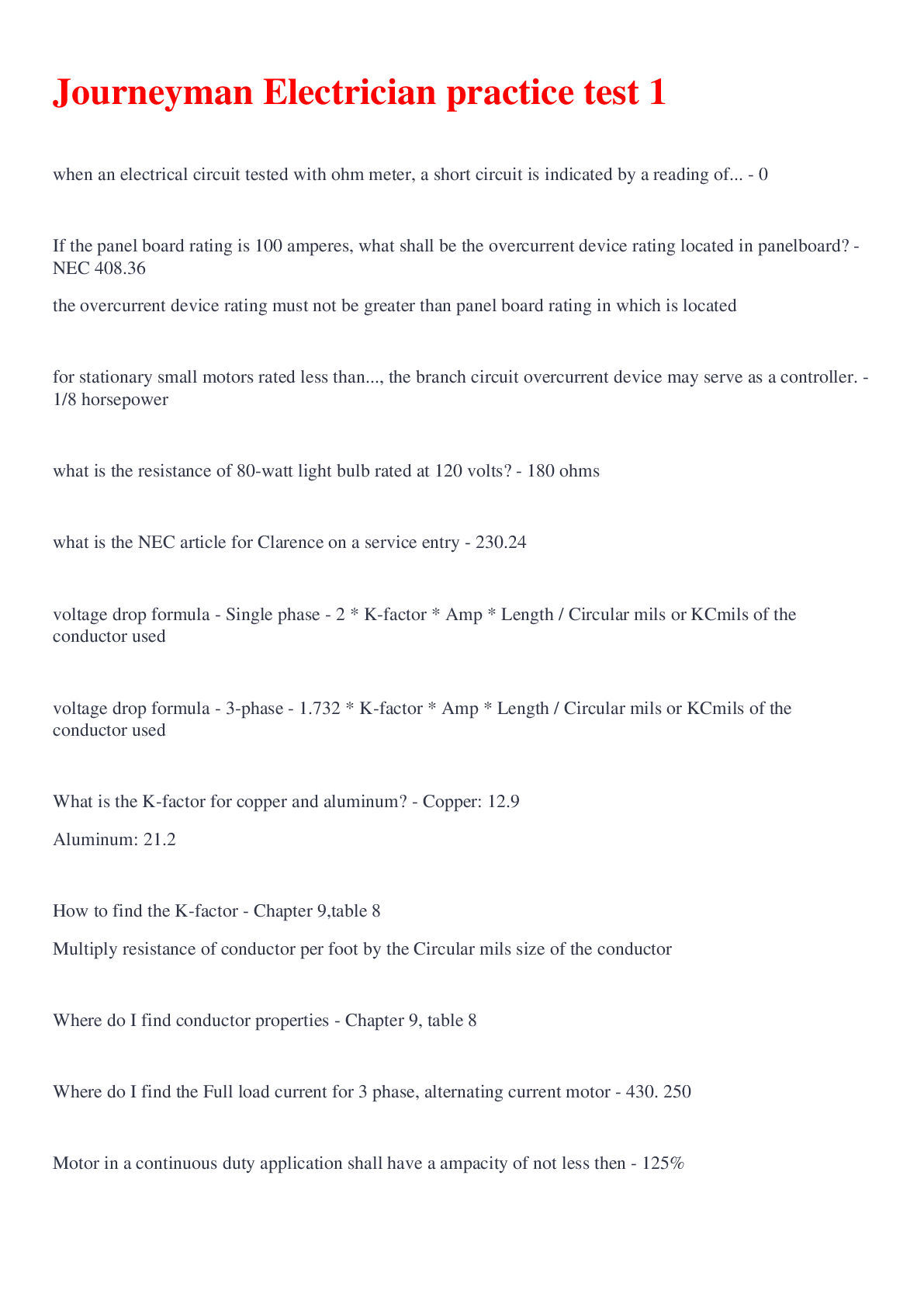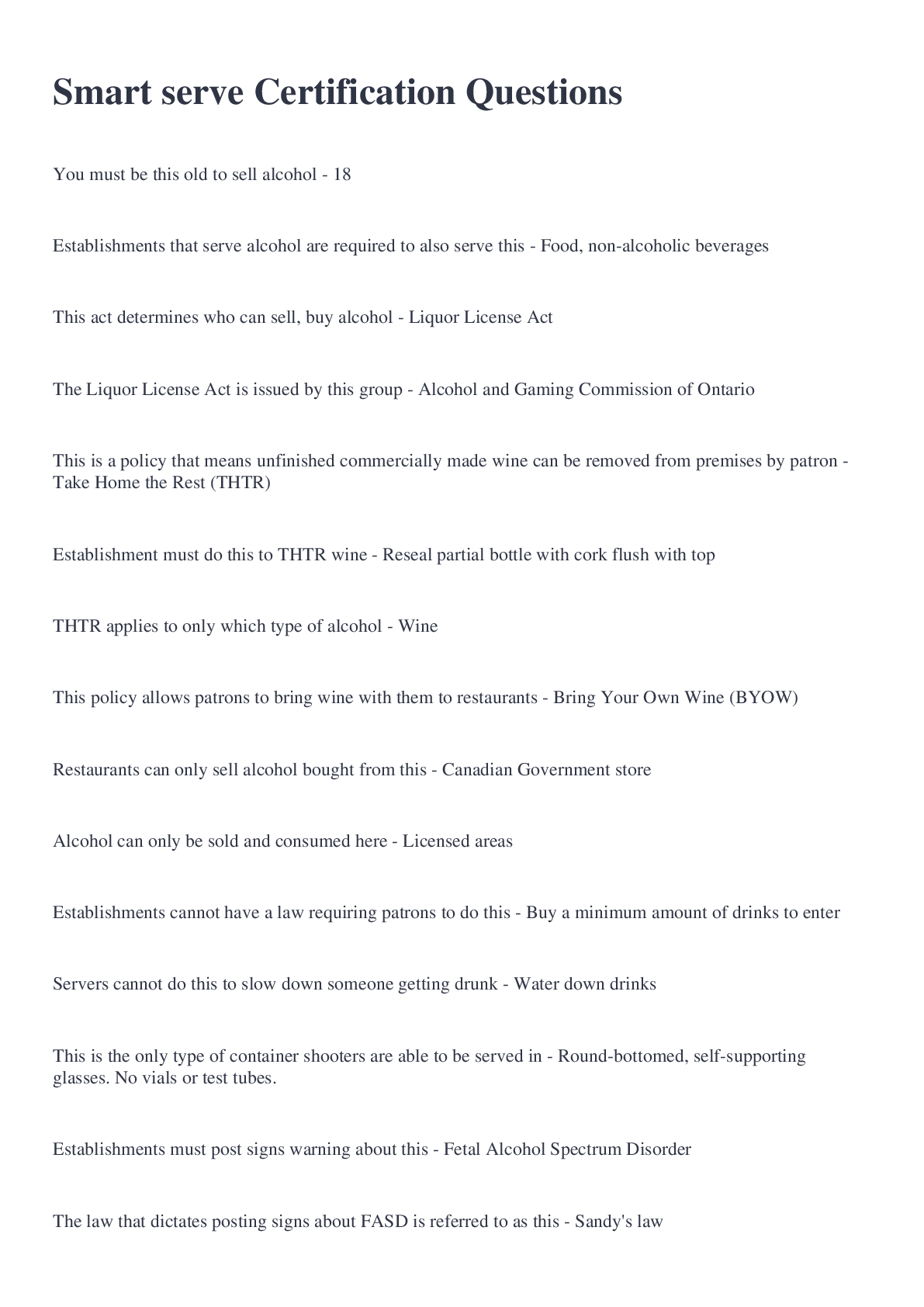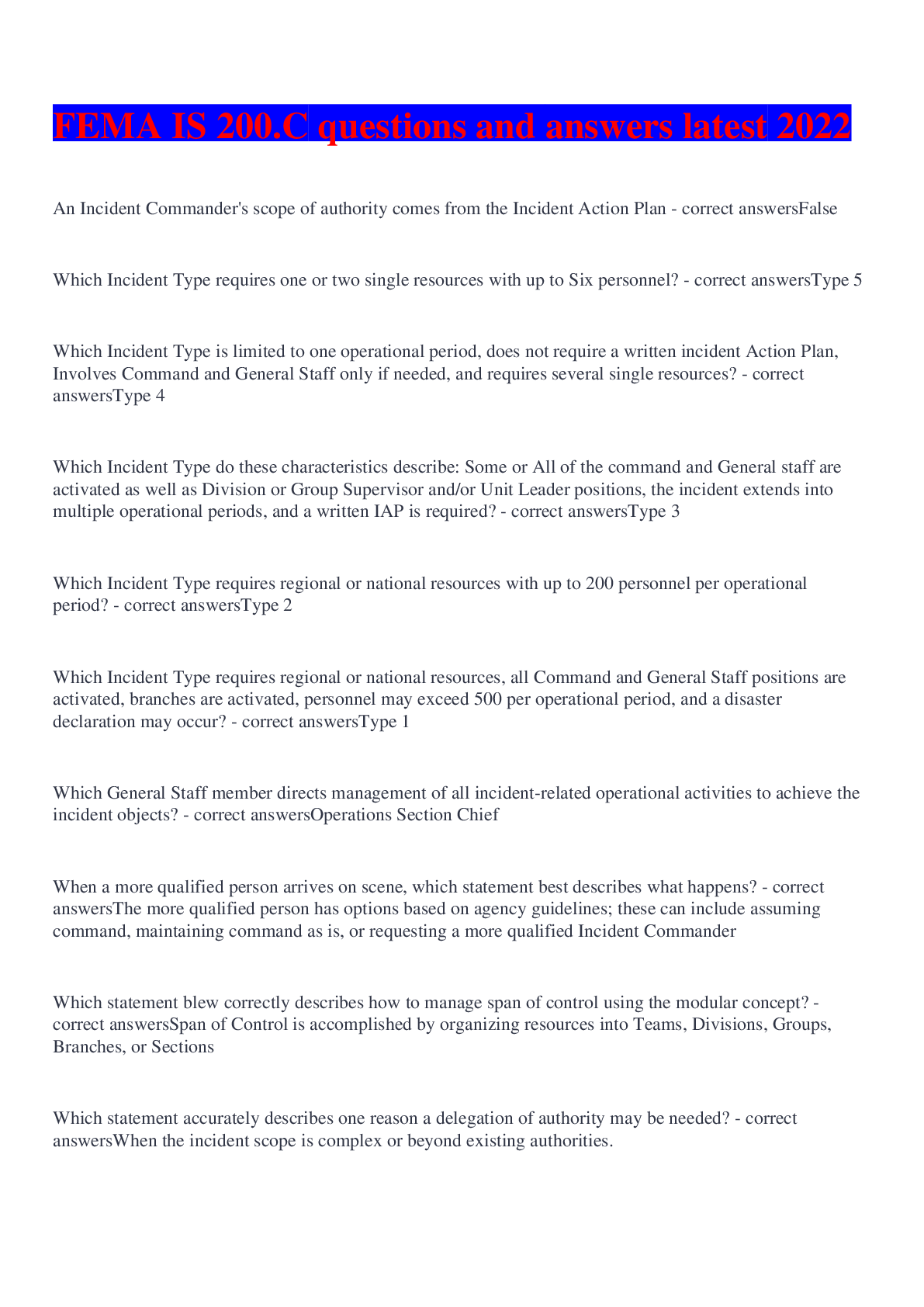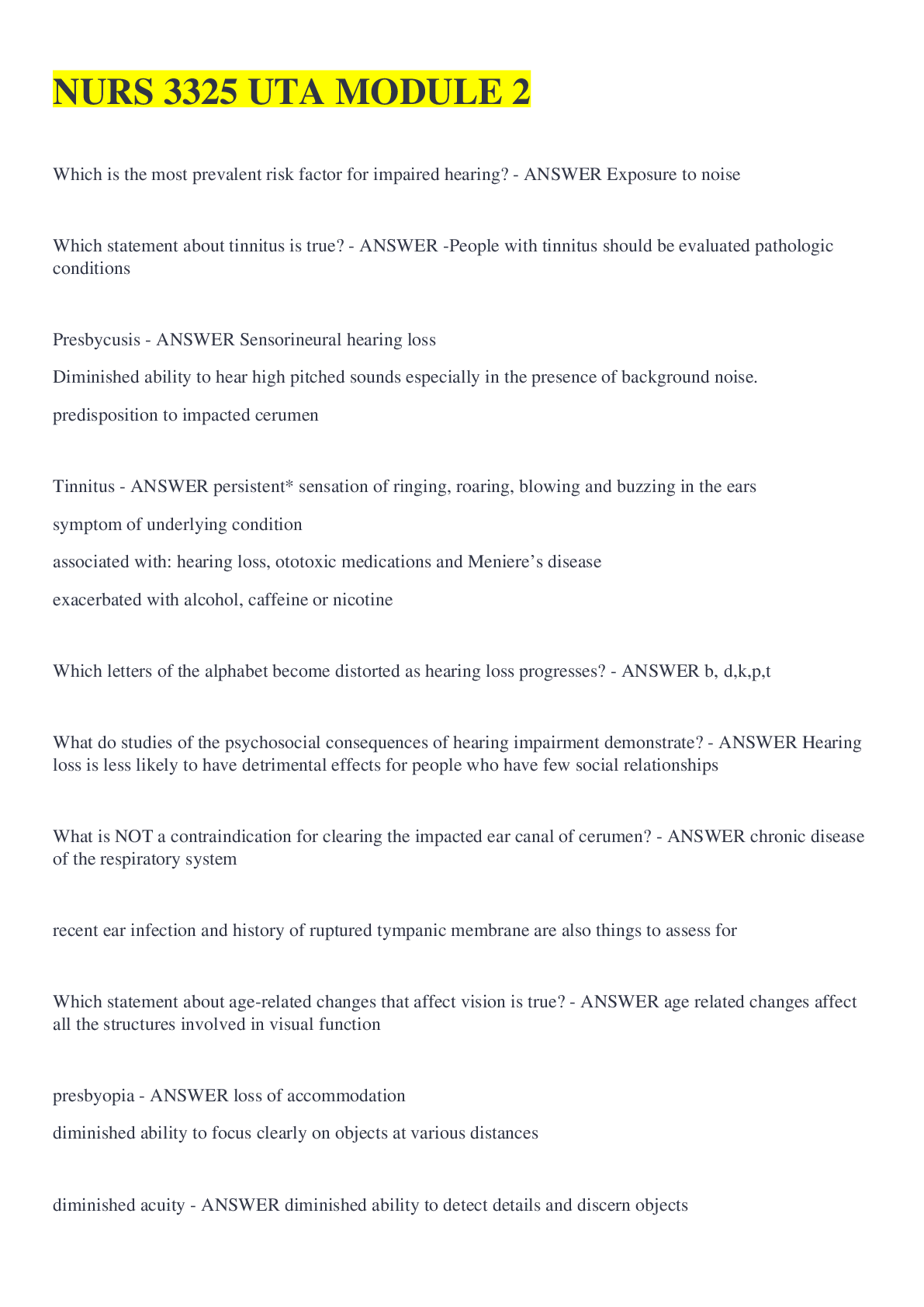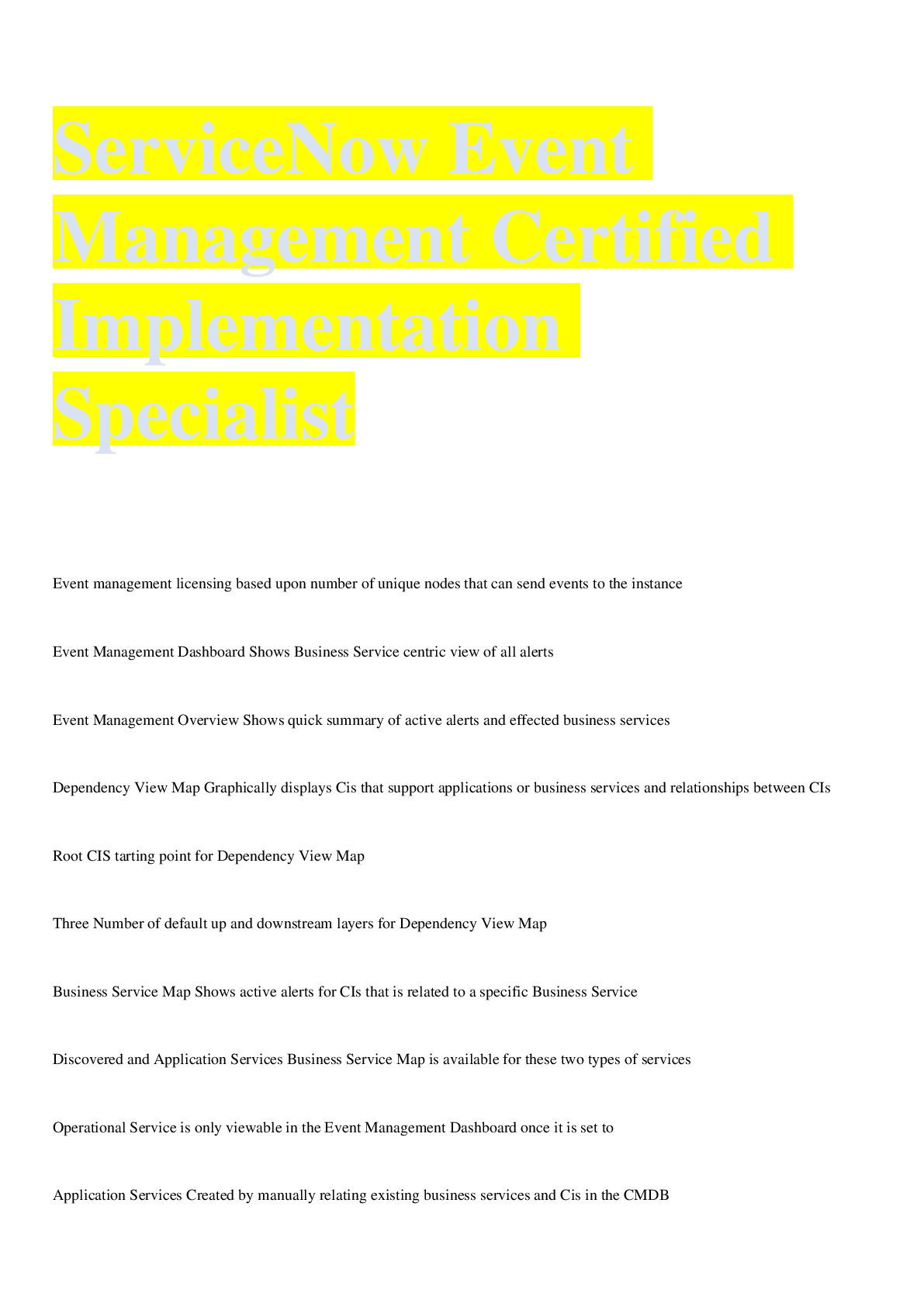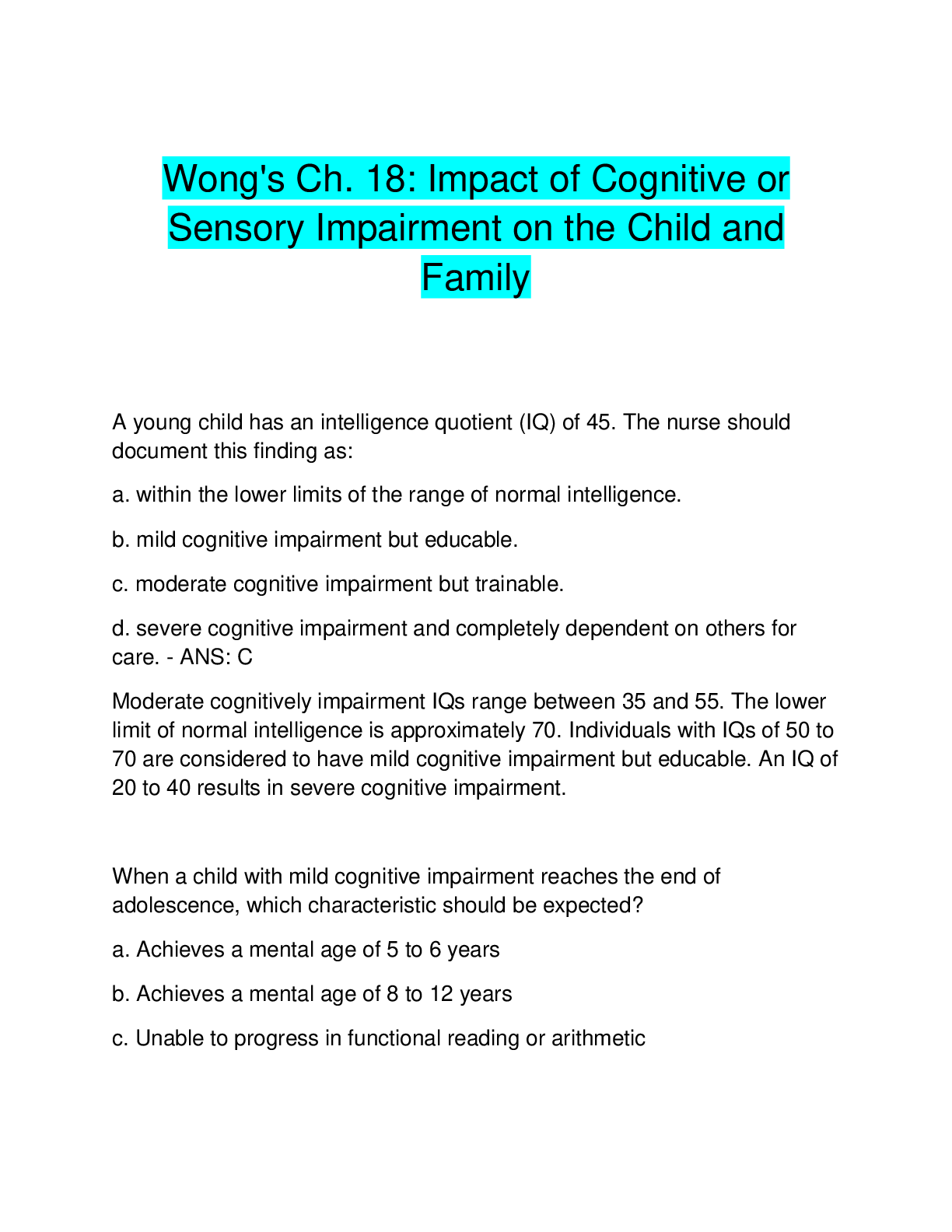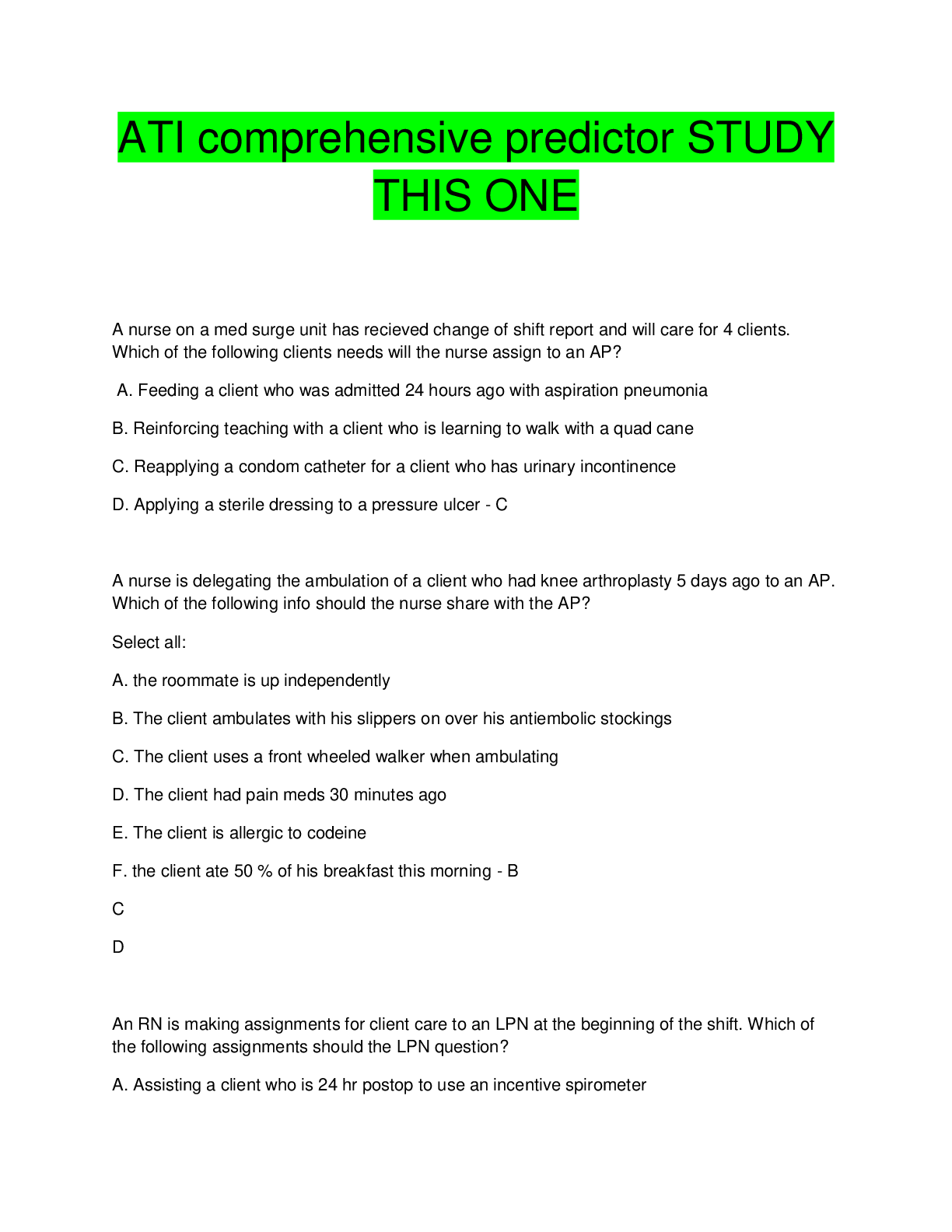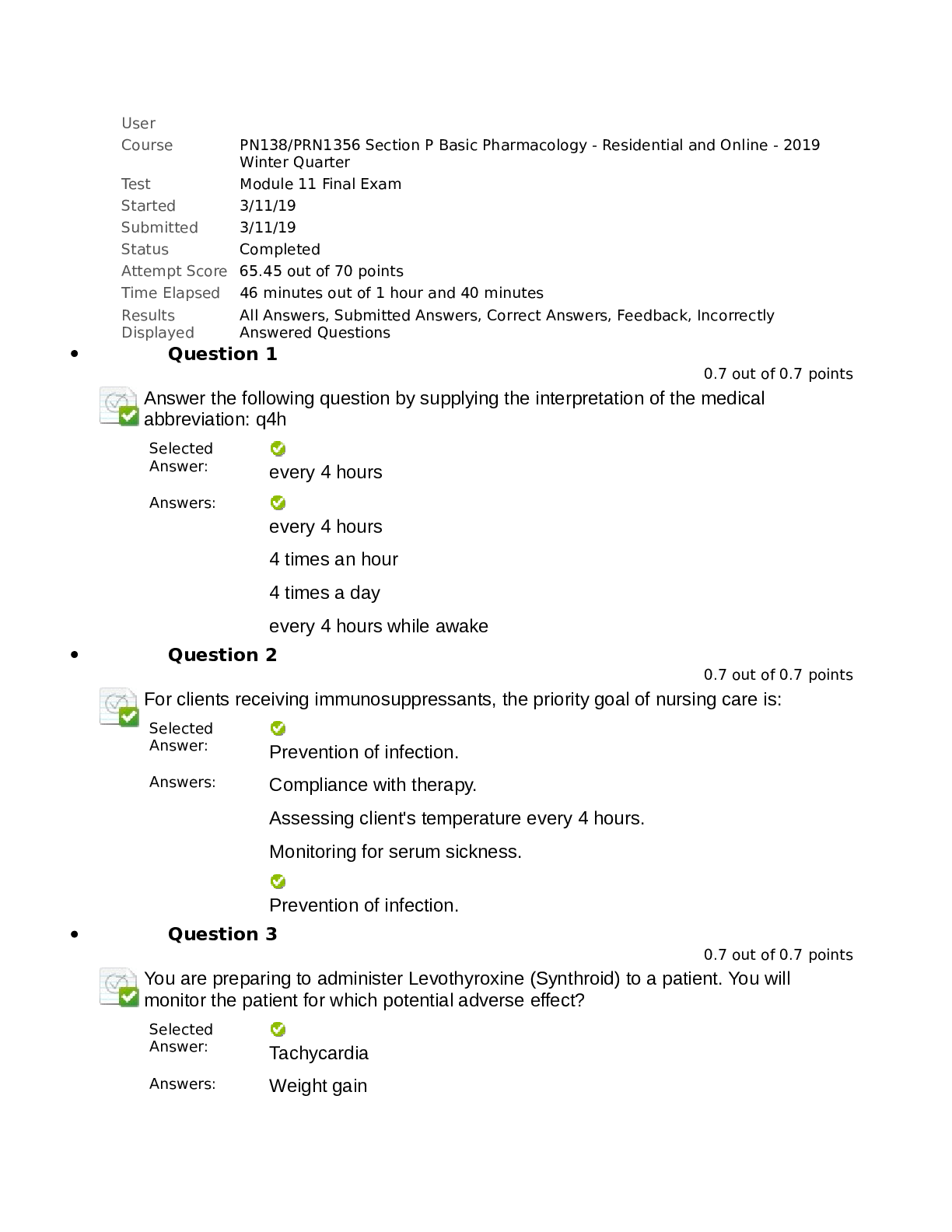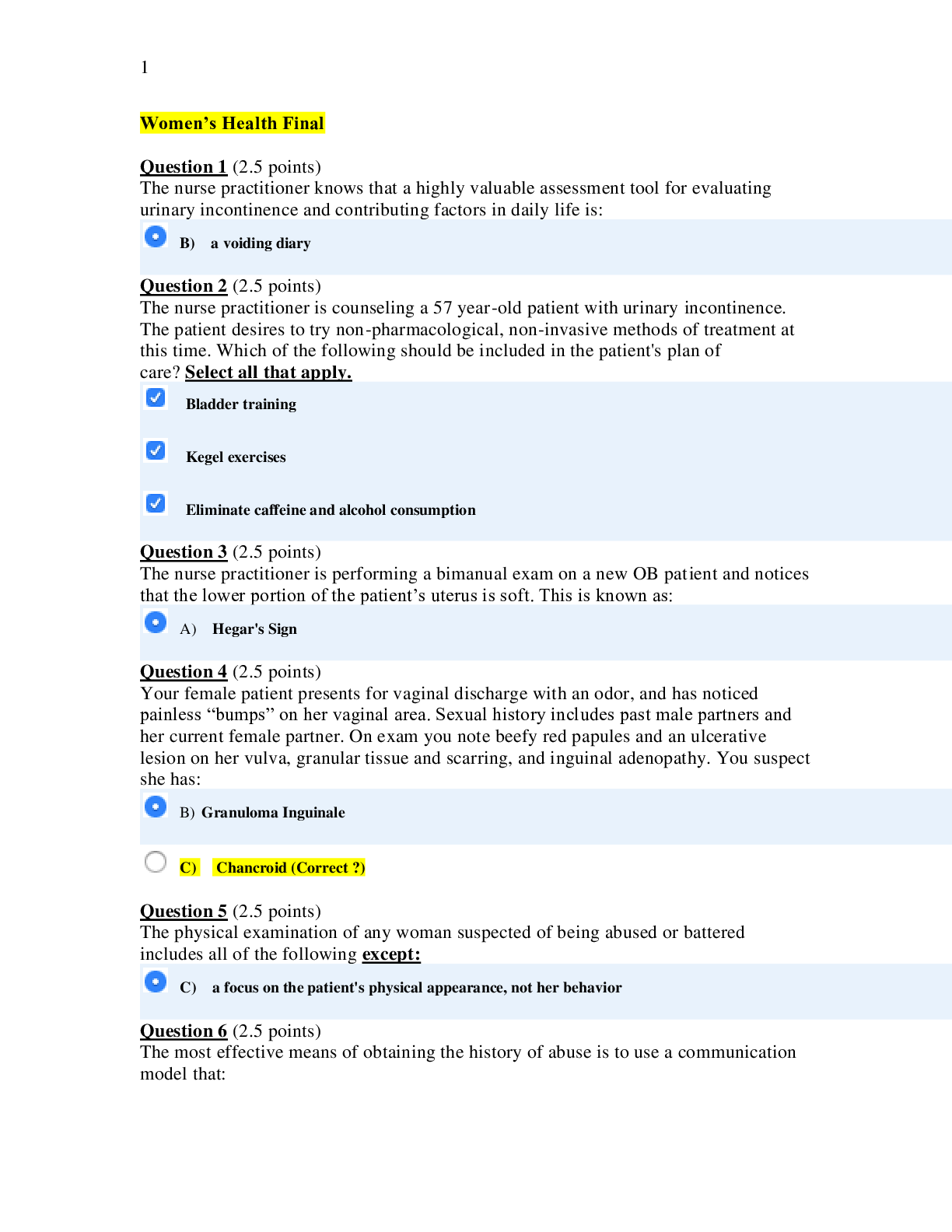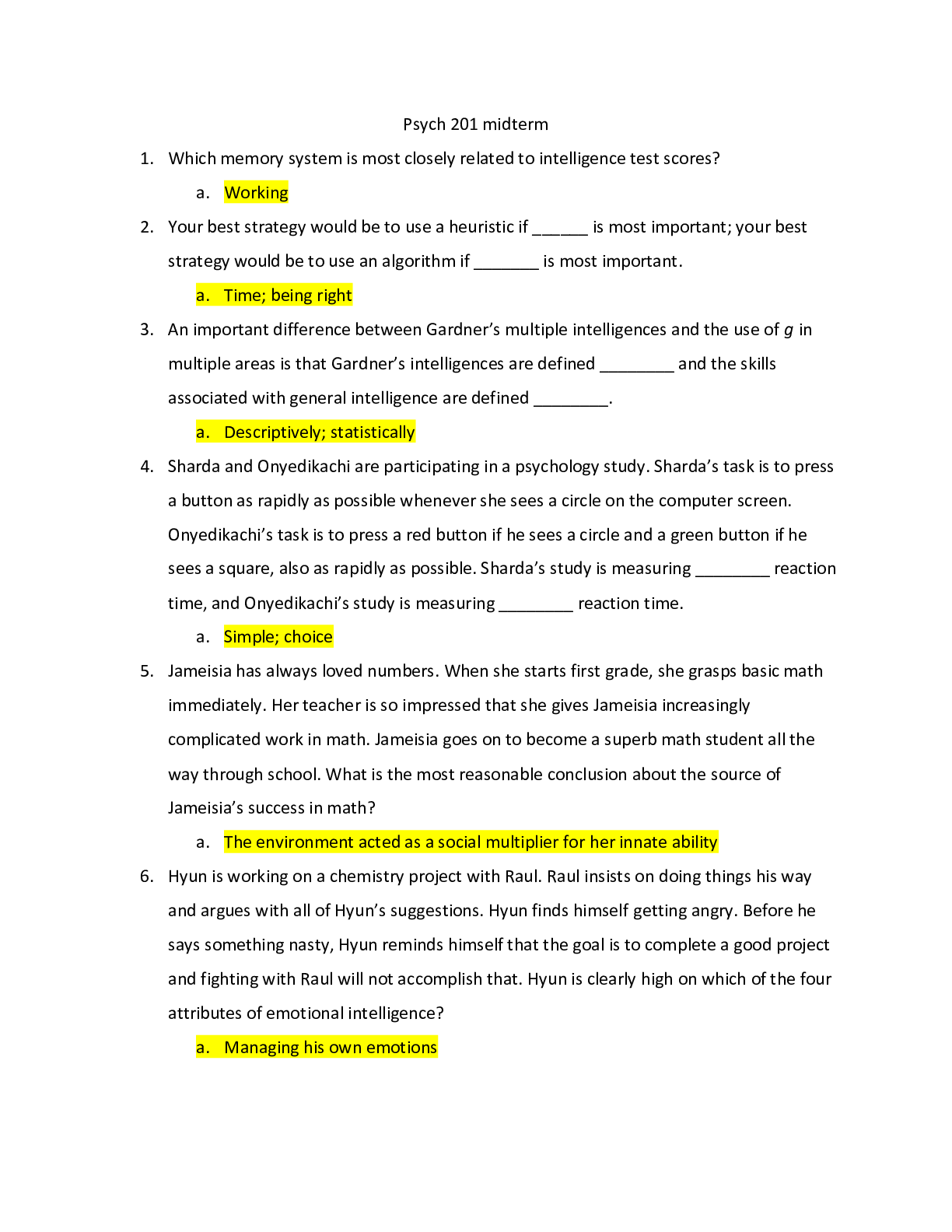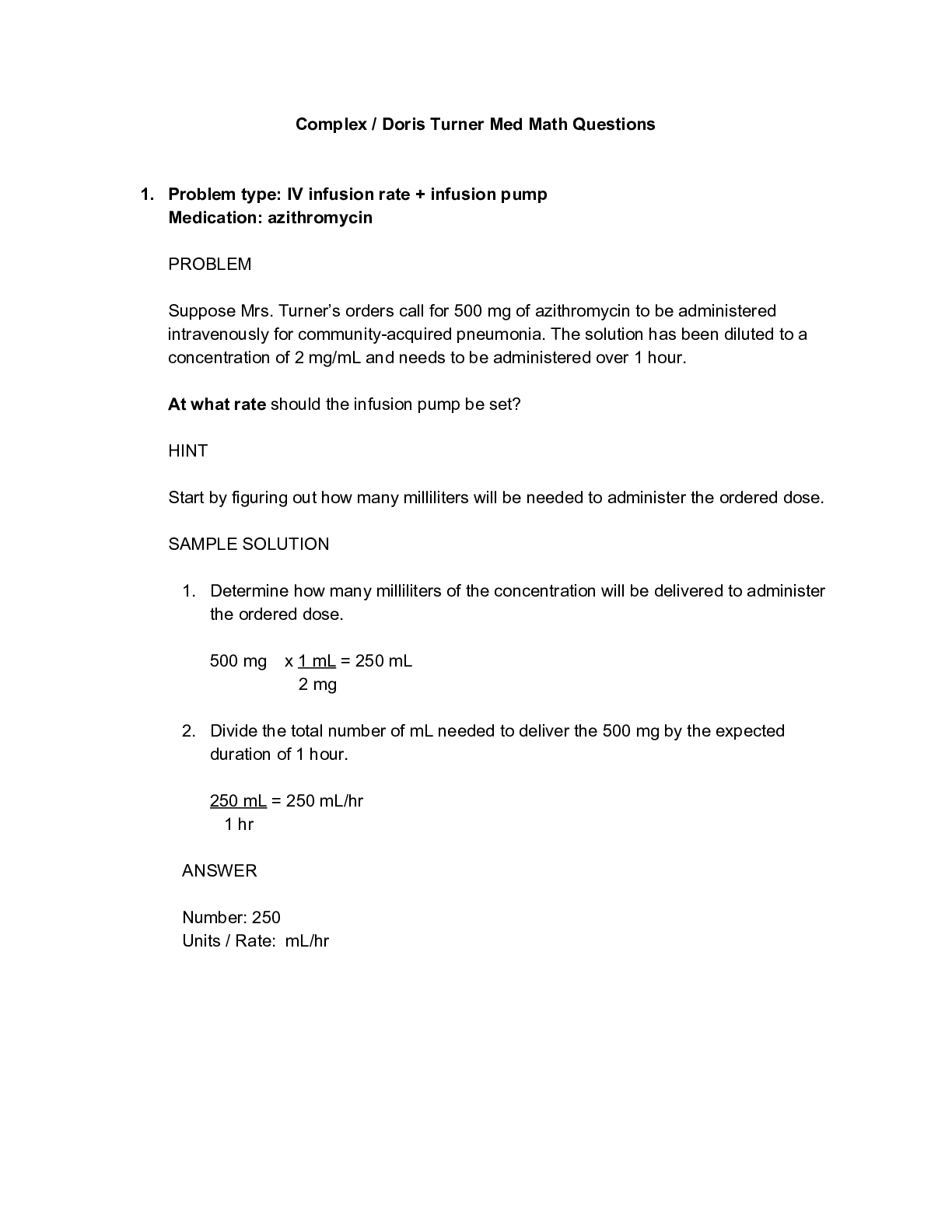NP235 Exam 2 Review questions with complete solution updated 2022
Document Content and Description Below
What is Adrenal Crisis? Physical stress from the flu or other infection, or from surgery, can send a patient with Addison disease into Addisonian crisis. Another situation that can cause symptoms of ... acute lack of cortisol results from prescribed treatment. What are s/s of adrenal crisis? The patient experiences generalized malaise and muscle weakness, muscle pain, orthostatic hypotension, and vulnerability to cardiac dysrhythmias. Insufficiency of the glucocorticoids affects blood glucose levels and causes symptoms of hypoglycemia. There is also decreased secretion of gastrointestinal enzymes, which results in anorexia, nausea and vomiting, flatulence, and diarrhea. These symptoms, as well as anxiety, depression, and loss of mental acuity, have been correlated with the absence of the peaks of cortisol output that normally occur every 24 hours. What is DIC? Damaged tissue liberates tissue thromboplastin, creating a state of excessive clotting in the microcirculation throughout the body. When excessive clotting depletes the body's clotting factors, hemorrhage follows, leading to hypotension or shock. What are s/s of DIC Continued bleeding from an injection or IV site, extensive bruising in areas of injury, ecchymoses where there has been no trauma, and petechiae. There may be oral, vaginal, or rectal bleeding. Laboratory studies will reveal a decreased hemoglobin and low platelet count. The prothrombin and activated partial thromboplastin times will be increased. The fibrinogen level is reduced, and the fibrin degradation products level is increased. The D-dimer result is elevated. What are s/s of hypoglycemia? Increase pulse, confusion, HA, Nervous, Nausea, Cool and clammy skin, shaking where is insulin manufactured in the body The pancreas is both an endocrine (secretes into the bloodstream) and exocrine (secretes through a duct to the target tissues) gland. Its endocrine function is to produce the hormones insulin and glucagon. What is diabetes mellitus type 2 formerly called non-insulin-dependent diabetes mellitus (NIDDM)—makes up 90% to 95% of all known cases of diabetes. Type 2 diabetes is believed to begin with insulin resistance, in which insulin interaction with glucose becomes less efficient, and therefore glucose metabolism is abnormal. More insulin is produced by the pancreas to maintain cellular metabolism. Type 2 diabetes has a tendency to develop later in life than does type 1, and patients with type 2 rarely develop diabetic ketoacidosis. What are some risk factors for DM type 2? obesity asian, hispanic, african american, American Indian In type 2 diabetes there also seems to be a relationship to aging and a reduction in the function of the pancreatic beta cells and how they synthesize insulin. Raynaud's disease characterized by spasm of the arteries of the upper and lower extremities with an exaggerated response to cold and stress, resulting in bilateral vasospasm. what education would you provide to your patient to prevent complications of Raynauds disease protect the extremities from cold, stress, vasoconstriction! The patient should be taught to: Dress warmly when in cold environments. Clothing should be layered and nonrestrictive. Hat, gloves, and warm socks should be worn. Wear protective gloves when reaching into ovens and when handling extremely cold items. Avoid cold temperatures when possible, to manage stress, and to stop tobacco use. Caffeine intake should be limited. If appropriate, the patient should be referred to a smoking cessation program. What does a patient take thrombolytics for give to stroke pts. they disolve clots. at risk for hemorrage. Anticoagulants work by preventing blood clots from forming. Some do this by preventing the body from making clotting factors. Others keep the clotting factors from working or prevent other chemicals from forming so that clots can't develop What is the priority in treating sickle cell patients administration of oxygen, pain-relieving drugs, and oral and intravenous fluids to reduce pain and prevent complications. Doctors also may recommend blood transfusions, folic acid supplements, and antibiotics. A bone marrow transplant may be an effective treatment in some circumstances What would be the plan of care for a patient with Peripheral Vascular Disease? Reduction of high blood pressure(2) Long-term control to decrease the risk of stroke, heart attack, loss of vision, and kidney disease. The target is to control blood pressure at or below 120/80 mm Hg. Sodium should be kept to less than 2400 mg/day. Alcohol intake should be moderated. Aerobic exercise of 30 to 45 minutes most days of the week is recommended. What is Percutaneous Transluminal Coronary Angioplasty aka PTCA? a nonsurgical interventional technique to open blocked coronary arteries. It is performed in the cardiac catheterization laboratory using fluoroscopy. A catheter with a balloon tip is threaded into the blocked artery, and when the narrowed area is reached, the balloon is inflated, pushing aside the plaque and widening the interior of the artery and a stent is usually placed. What are some signs and symptoms of Thrombocytopenia? Bleeding into the joints (hemarthrosis) is not uncommon in certain kinds of anemia or in hemophilia. for hospitalized pts. abdominal girth should be measured daily to detect internal bleeding Blood loss in the GI tract from an ulcer, tumor, or hiatal hernia can be in small amounts or in a large enough amount to make stool appear black (melena). Loss of 50 to 75 mL of blood from the upper GI tract is required before melena will appear. What are some signs and symptoms of anemia? Pigment loss and yellowish cast to the skin paleness in the conjuntevia of the eyes and mucous membranes. fatigue, malaise How do you treat Inappropriate Antidiuretic Hormone? correcting the underlying cause; restricting fluids to 500 to 1000 mL/day; and administering sodium chloride, diuretics, and demeclocycline (a tetracycline) to increase excretion of water. Tolvaptan (Samsca) is approved for the treatment of hyponatremia in SIADH. Tolvaptan improves serum sodium levels within 8 hours when given as an IV infusion by blocking the action of ADH; however, there is a danger of overcorrection, and sodium levels need to be closely monitored. What are some signs and symptoms of an Acute Myocardial Infarction? Chest discomfort, including feeling of tightness, aching, burning Chest pain (angina pectoris) radiating to the arm, jaw, or back Dyspnea (shortness of breath) Palpitations or tachycardia Nausea and vomiting Cold, clammy skin Undue fatigue (particularly in women) Weakness and inability to complete usual activities without chest pain or dyspnea What are some characteristics seen in females? With Myocardial Infarction? women are more likely to have other symptoms along with chest discomfort, such as shortness of breath, nausea and extreme fatigue. What is Diabetes Insipidus? occurs after trauma or surgery in the area of the pituitary or hypothalamus and may be temporary or permanent. Characterized by the production of copious amounts of dilute urine. DI results from decreased production of antidiuretic hormone (ADH), which regulates reabsorption of water in the kidney tubules. When ADH is not present in a sufficient amount, the water is not reabsorbed from the tubule and is excreted as urine. What are some signs and symptoms of Diabetes Insipidus? profound diuresis (production of a large amount of urine), often as much as 3 to 20 L in every 24-hour period. Other signs and symptoms include thirst, weakness, and fatigue, often from nocturia (urination at night). The patient will exhibit signs of deficient fluid volume, such as tachycardia, hypotension, weight loss, constipation, and poor skin turgor. If untreated, the patient will demonstrate signs of shock and central nervous system manifestations progressing from irritability to eventual coma from hypernatremia and severe dehydration. . What is the Somogyi phenomenon follows a period of hypoglycemia, often during sleep. When hypoglycemia occurs, the body secretes glucagon, epinephrine, growth hormone, and cortisol to counteract the effects of low blood sugar. The patient may report nightmares and night sweats along with morning elevated serum glucose; if the patient increases the insulin dose, it worsens the problem. What is Diabetic Ketoacidosis? caused by incomplete metabolism of fats resulting from an absence or insufficient supply of insulin. When insulin is not present in adequate amounts to meet metabolic needs, the body breaks down protein and fat for energy. This produces an abundance of the by-products of fat metabolism, which are potent organic acids called ketones. s.s of diabetic Ketoacidosis? Increased thirst (polydipsia) Increased urination (polyuria) Acetone breath odor ("fruity") Dry mucous membranes and sunken eyeballs (dehydration) Nausea and vomiting Deep respirations (Kussmaul respirations) Abdominal pain and rigidity Paresthesia's, weakness, paralysis Hypotension Minimal urine output (oliguria) or none (anuria) (late sign) Stupor or coma (late sign) [Show More]
Last updated: 1 year ago
Preview 1 out of 10 pages
Instant download
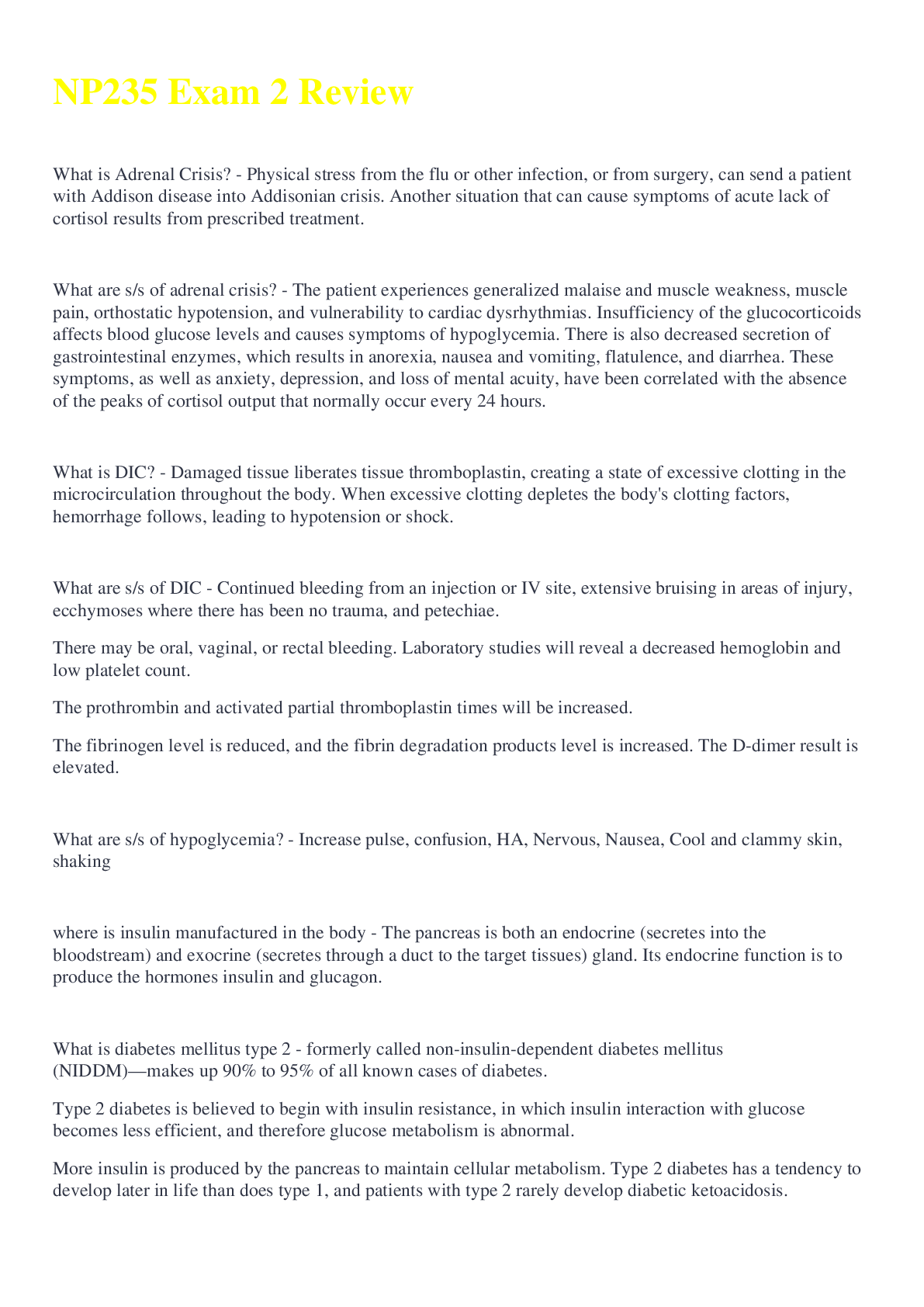
Buy this document to get the full access instantly
Instant Download Access after purchase
Add to cartInstant download
Reviews( 0 )
Document information
Connected school, study & course
About the document
Uploaded On
Oct 20, 2022
Number of pages
10
Written in
Additional information
This document has been written for:
Uploaded
Oct 20, 2022
Downloads
0
Views
28

